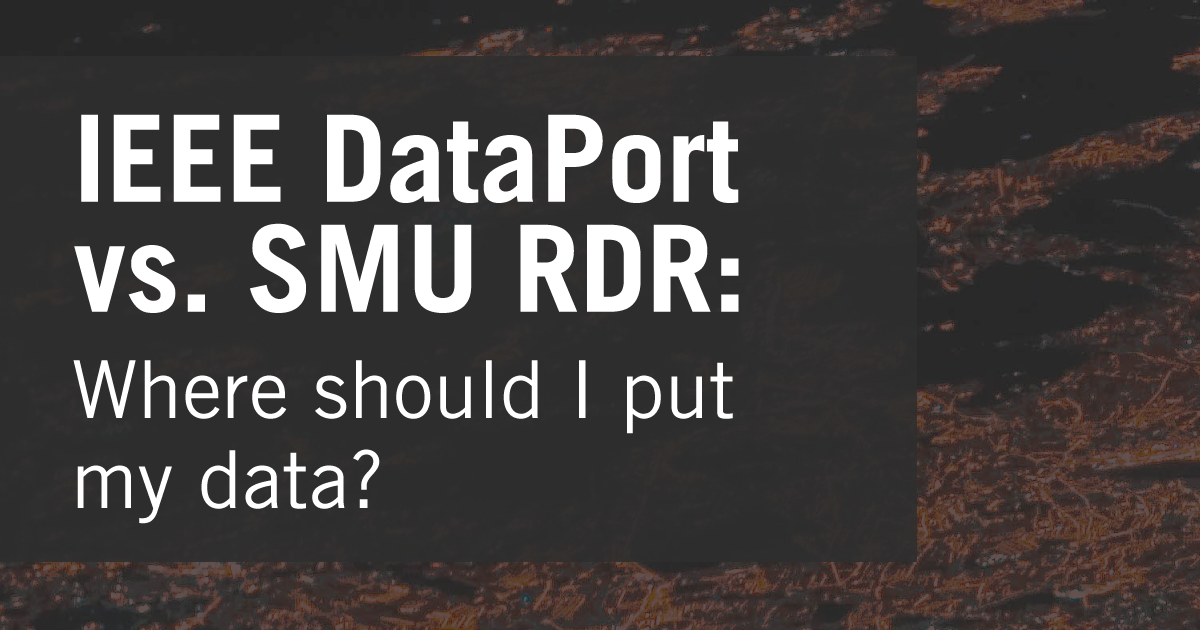
by Dong Danping, Librarian, Research Services
Data repositories are increasingly used by academics to store, publish or archive data to support reproducible research and long-term data availability. This article examines the differences between IEEE DataPort and SMU RDR (hosted on Figshare) to help researchers make a more informed decision on where to store, archive, or publish data.
IEEE DataPort is an online data repository that “hosts technical material, including datasets and data analysis tools, of interest to the engineering community”. It is developed and supported by IEEE, an important and well-known publisher in electrical engineering, computer science and related fields. The platform has been active since 2019.
SMU RDR is supported by SMU and hosted on Figshare, an open repository service for sharing of data and other types of academic research outputs. Figshare was established in 2011 and used by a number of publishers (e.g. SpringerNature, PLOS, SAGE) and institutions (e.g. Carnegie Mellon University, Monash University and more).
While both IEEE DataPort and SMU RDR (Figshare) may seem similar in the sense that they allow users to upload and publish data on the web, there are some noteworthy differences.
Open data
The most important difference is how open data is on these two platforms, which matters if your goal is to disseminate your research output and make an impact by publishing open data.
IEEE Dataport makes it free to upload datasets up to 2TB, but access to the datasets is behind a paywall. It means that if someone wants to access the data, they need to pay for a personal subscription ($40/month) or an institutional subscription (from $4,500 - $22,500+ per year) to IEEE DataPort. If the data owner wants to make their data open to non-subscribers, they need to pay a fee of $1,950 per dataset.
The strength of IEEE DataPort lies in the fact that it is more embedded in the workflow for IEEE-owned journals. However, the subscription-based model puts a cost barrier to the data for other researchers.
As a data owner, you have other options like using your institutional repository (e.g., SMU RDR) or other recognized data repositories which do not charge fees.
SMU RDR is free for all SMU researchers to use and supports uploads up to 5TB per record. Published datasets are open and adhere to the principles of FAIR data. It is also visible and discoverable in Google, Google Dataset Search, DataCite and ScholeXplorer (and services relying on it such as Scopus).
Some researchers may prefer other established open data repositories such as Zenodo, which also have great support for open data. However, IEEE DataPort is less desirable for data sharing by putting research outputs behind a pay wall, which limits access and data reuse and is not in line with the principles of open data, open science or the FAIR principles for data management.
Private data storage and/or group collaboration
Researchers may not be ready to share their data openly but wish to store them at a secure location as a backup or for long term access. SMU RDR supports such use cases, allowing private data storage only accessible to you or selected individuals in your research group. If you are a GitHub or OSF user, RDR can be integrated with these services to provide additional storage space, to mint a DOI for your dataset or to act as backup storage.
In comparison, IEEE DataPort is limited to data publishing. Once the data is uploaded, it is available to subscribers of IEEE DataPort.
Long-term retention and sustainability
Researchers want to archive their data so that it will be available and accessible in the long term. IEEE DataPort’s Terms of Use states that “Authorized User understands that IEEE DataPort is made available at the discretion of IEEE. IEEE reserves the right to change, suspend, or terminate the Repository at any point and for any reason.” Long-term sustainability of this service is not guaranteed, and your data may not be available any more should IEEE decides to stop offering this solution.
The good news is that if your data is already on IEEE DataPort, you can still put a copy in SMU RDR based on the Terms of Use.
SMU RDR complies with standards and best practices for open data repositories such as the TRUST principles for digital repositories and is able to meet multiple funder requirements, e.g., OSTP, NIH, UKRI. Public data will be also deposited to Chronopolis for further preservation and additional peace of mind.
If you have any questions or need support on data management or data repositories, email the library or contact me directly at dpdong@smu.edu.sg.
Table: Comparison of IEEE DataPort and SMU RDR
| IEE DataPort | SMU RDR (Figshare) | |
|---|---|---|
| Private storage space | NA | 100GB/user by default (contact SMU Libraries to request for increase) |
| File size limit | Up to 2TB per file | Up to 5TB per file |
| Open data | Default paywalled (Data owner can pay $1950 per dataset to make it open) |
Open data publishing without charge |
| Other access options | NA | Data can be “as closed as necessary” Options include:
|
| Private link sharing | NA | Open data publishing without charge |
| Other access options | NA | Yes |
| DOI minting | Yes | Yes |
| Tracking citations to data | NA | Yes (example record with citations) |
| Altmetrics | No | Yes |
| License options | CC-BY only | A list of options available |
| Collaboration features | NA | Yes. See guide on How to Collaborate with SMU RDR |
| Integrations with other services | Integration with ORCID and AWS | Integration with ORCID, GitHub, OSF, Binder, Overleaf and more |
| Open API | NA | Free and open API |
| Ways to upload data |
|
|
| Long-term retention & sustainability | Not guaranteed |
|